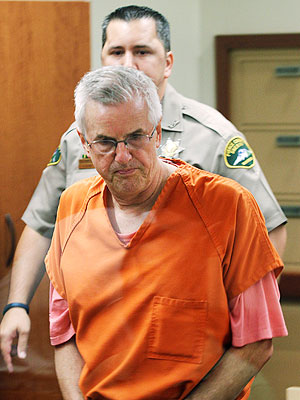SAN FRANCISCO — The first thing James Cameron saw 7 miles below the sea was man-made: tracks from a remotely operated vehicle.
“When I got to the bottom, I saw skid marks from the ROV,” Cameron said yesterday (Dec. 4) here at the annual meeting of the American Geophysical Union, referring to a 2009 survey by the Monterey Bay Aquarium Research Institute. Scientific results of the film director’s expedition to the Mariana Trench were presented at the meeting this week, and Cameron and the researchers described the highlights to a packed crowd.
Cameron reported a new, corrected depth for his landing — 35,803 feet (10,912 meters) — which beats by five feet (1.5 m) the record set by U.S. Navy Lt. Don Walsh and Jacques Piccard in 1960 at the same spot. However, “because the error [calculating the depth] on Don’s dive is much greater, we’re just going to have to call it a tie,” Cameron said.
Deepsea Challenger
Cameron’s Deepsea Challenger expedition made dives to the New Britain Trench and the Mariana Trench in the southwestern Pacific Ocean between Jan. 31 and April 3, with one manned dive by Cameron to the Mariana’s Challenger Deep, the deepest spot in any ocean.
Unusual, never-before-seen species were snared and brought back to the surface. A bizarre microbial mat community was discovered living on altered rocks in the Sirena Deep, another deep pool 6.77 miles (10.9 kilometers) below the surface.
Changes in temperature and salinity starting at 26,200 feet (8 km) deep hint at an unknown current coming into the Challenger Deep, said Doug Bartlett, a microbiology professor at the Scripps Institution of Oceanography at UC San Diego.
The filmmaker journeyed inside a high-tech lime-green machine — a steel sphere encased in foam — dubbed the Deepsea Challenger. The expedition traveled with two unmanned seafloor “landers” — large contraptions hoisted over the side of a ship and dropped to the seafloor. Once on the bottom, bait attached to the lander lured seafloor creatures to the craft, and a suite of instruments took samples, photographs and data. [Images: James Cameron's Historic Deep-Sea Dive]
The two contraptions working together proved to be a very good system, Cameron said. “We could rendezvous on the bottom and see the results of that bait running for six to eight hours, and that’s how Doug could find a new species of giant arthropod,” Cameron said.
Challenging journey
The March 26 dive proved to be a physical and mental challenge for Cameron. “I did yoga for six months so I could contort myself into the sphere,” he said.
As he sank through the water, Cameron said he “burned though my whole checklist,” designed to distract him during the long hours of the dive. “I still had 3,000 meters left to go with pretty much nothing left to do but sit quietly and think about the pressure building up around the hull,” he said.
The sub touched down gently, and Cameron immediately took a sample of the seafloor, as planned. This was a good contingency, because the sub’s hydraulic fluid line then burst, leaving him unable to collect more samples.
To his surprise, the sub’s voice communications worked perfectly. “We actually expected they wouldn’t, and I would have to default to texting,” he said. “Texting while driving is not a good thing, especially if you’re using two hands to operate seven joysticks and you’re 7 miles down.”
Cameron first drove the sub about 200 meters, finding the seafloor elevation stayed the same. In fact, Challenger Deep turned out to be remarkably flat, and the sub was easy to drive. “The vehicle was quite nimble, the sub’s yaw rate was very good,” he said. (Yaw describes the left-to-right rotation of a craft.)
A quick return
After about three hours, some of the submersible’s batteries had low charge readings, the steering was problematic, and it was time to return to the surface. The mission should have lasted five to six hours. “I hate this. I hated having to go back,” Cameron recalled thinking.
The trip to the top was mercifully short at 73 minutes. The submersible covered nearly 7 miles in a little over an hour — slow in a car, but like riding a missile for a human in a metal ball. Cameron said the surface trip is when he noticed the aches and pains from the cramped sub. “That’s when your butt is really sore, and when you notice how much it hurts.” [Infographic: James Cameron's Mariana Trench Dive]
The sub now sits in a barn in Santa Barbara, waiting for Cameron or another group with enough money to send it back to the deep ocean. He declined to say how much it cost to build and mount the expedition.
“I would love for the sub to dive again,” he said. “I personally feel that we just barely got started before we had to turn back and there’s just so much out there.”
“And if not, at the very least, the technical innovations can be incorporated into other vehicle platforms,” Cameron added. “As far as I’m concerned, it’s an open source situation.”
Reach Becky Oskin at [email protected]. Follow her on Twitter @beckyoskin. Follow OurAmazingPlanet on Twitter @OAPlanet. We’re also on Facebook and Google+.
Copyright 2012 OurAmazingPlanet, a TechMediaNetwork company. All rights reserved. This material may not be published, broadcast, rewritten or redistributed.
Linux/Open Source News Headlines – Yahoo! News











